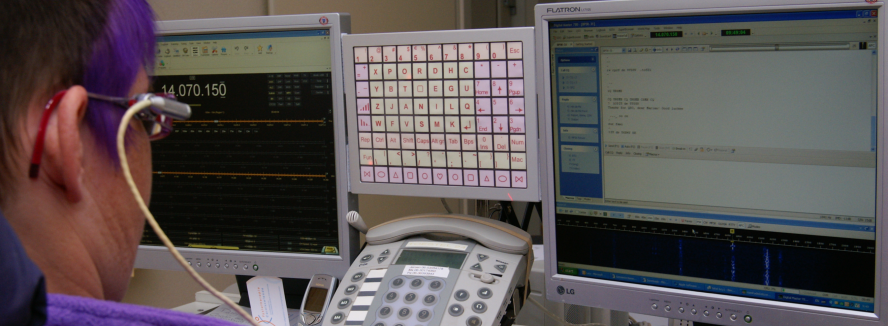
Severely diabled people operating a HAM radio

Playing with radios is a very nice hobby, or even more. That also goes for disabled people.
Depending on the severeness of their handicap, people can more or less operate a HAM radio. Some people however, cannot use their hands properly. Or
cannot speak clear enough. Or both.
When your voice cannot be heard well enough on the other side, and you cannot type on any kind of hand-operated keyboard (for PSK, RTTY, ...) and
there is also no thinkable way to operate a CW-key (not even with air-, kick- or headswitches), options run out fast.
Some people coping with severe cerebral palsy, dystrophy, (multiple) sclerose or high spinal cord lesion (paraplegia) just cannot operate a HAM radio
without help from other people.
When you still have some control over your head, you could use a Lucy-keyboard. Such a keyboard is operated with a laser mounted on a pair of
glasses or a headband. Lucy is recognised by Microsoft's Windows 98, 2000, XP and Vista as a normal USB-keyboard, therefore it will work with all your
software. Lucy is Plug-and-Play, you can plug it into every PC without installing or adjusting anything, so if a Lucy-user plugs it in into your own PC
he or she can work with your software (and rig!) instantly. You can also control your mouse with Lucy. When you have 2 screens attached to your PC, you
can have your rig on the one screen and your communication software on the other.
 Now we're talking! We need a radio with a CAT-interface, a soundcard interface, a computer with Windows and some software, both for PSK/RTTY/etc and
for the CAT-interface. I think, most of us could arrange that for such an experiment..... At last, we need a Lucy keyboard and a trained Lucy-user.
Now we're talking! We need a radio with a CAT-interface, a soundcard interface, a computer with Windows and some software, both for PSK/RTTY/etc and
for the CAT-interface. I think, most of us could arrange that for such an experiment..... At last, we need a Lucy keyboard and a trained Lucy-user.
For example, let me show you this configuration: a 2.5 GHz PC running Windows XP, running Ham Radio Deluxe 4.0 with Digital Master 780, a Yaesu
FT-897D and a MFJ-1275M soundcard interface. Nothing special about it! With HRD we can control the FT-897D completely from the screen, so that's half
the solution. The other half is DM780 so we can do PSK, RTTY, Throb, CW, SSTV, Domino, FSK, Olivia, and more. Now we can also communicate from the
screen.
Someone with severe cerebral palsy can still type a 100 keys a minute - close to PSK's ability! Lots of us can't type that fast. Therefore we use
macros with tags to fill in the callsign etcetera. Well, the Lucy user does that too, but also has some macros within her/his keyboard to even extend
the use of macros. In other words: he or she will outrun you! And using PSK, you will not see the difference between a severely disabled person and
someone who is not.
And that's what's it all about: .... you will not see the difference between a severely disabled person and someone who is not. We're talking about
really severe disabled people here. People who didn't stand a change before. Who never even dreamed about operating a HAM radio completely by themselves,
because there was just no complete solution for their problem. Only partial solutions exists, like a foot-switch for PTT. Or VOX-operation.
Now, there's a keyboard for those severely disabled people with which they can type as fast as any other person. Well, actually, the first Lucy was
build in 1980, so it's not really new. HAM radios are not new either, but the real turning point is the common use of soundcards and CAT-interfaces
thse days.
References:
Lucykeyboard.com
HRD / DM780
Disclaimer:
The author of this article, Jeroen PA3JT, has an indirect commercial involvement in the Lucy keyboard, except in the Netherlands, Belgium,
Germany and the UK. Honesty compels me to admit this fact. However, this article is only ment for informational purpose. The author is not involved
in HRD/DM780, nor Yaesu, which are only being used for example in this article.